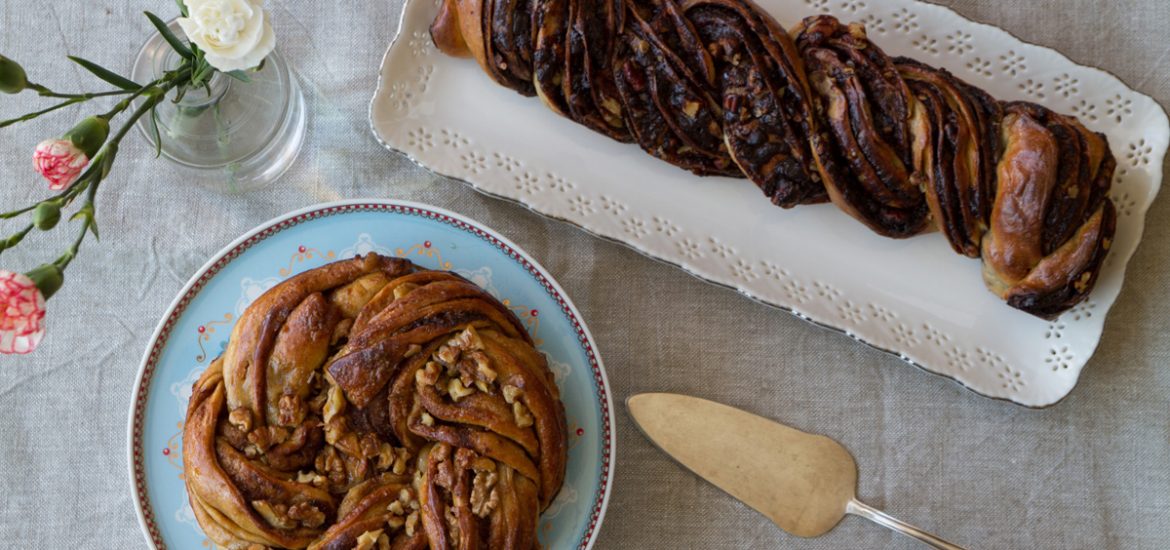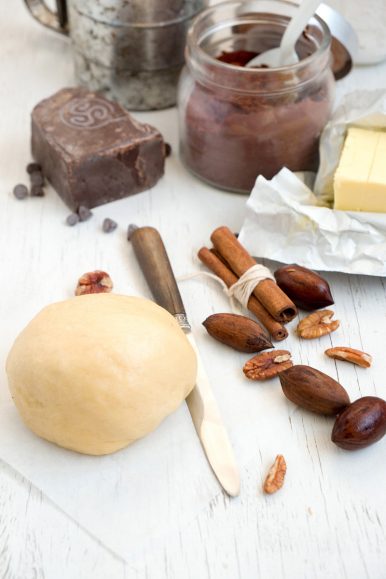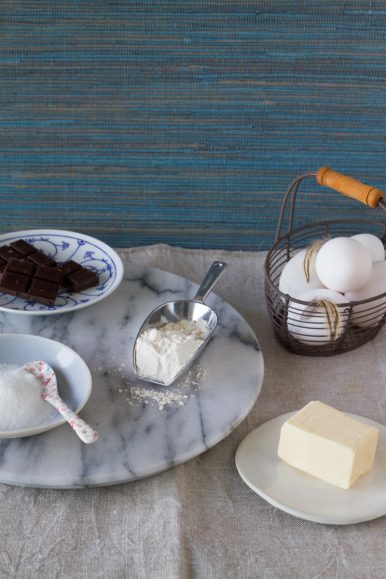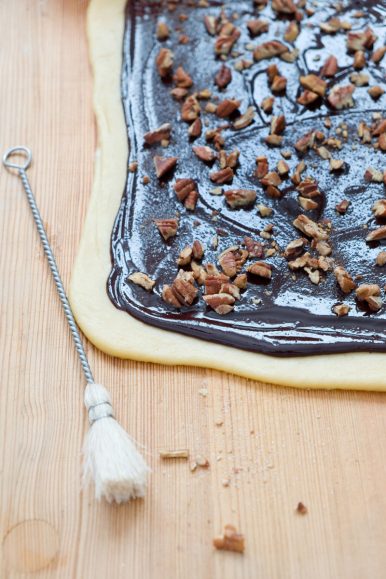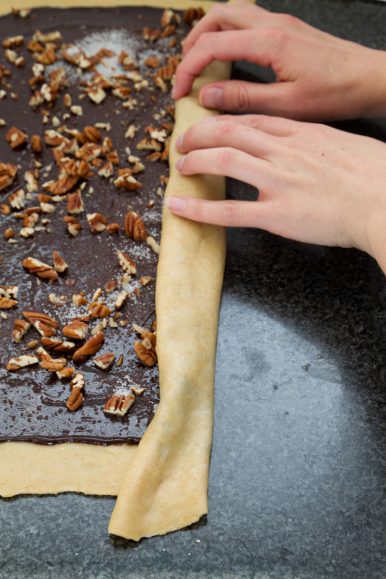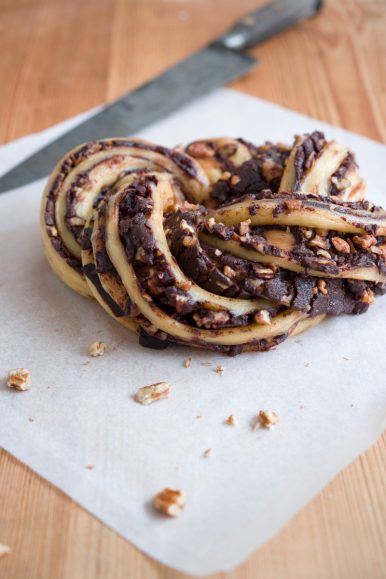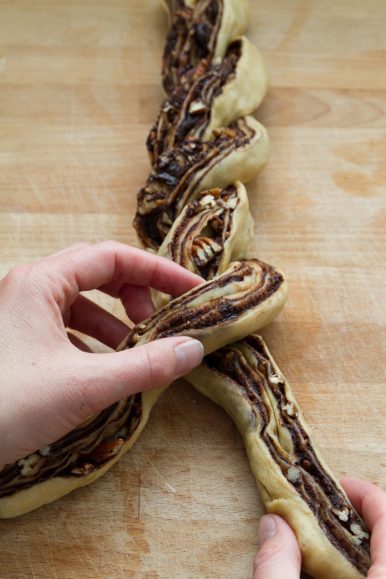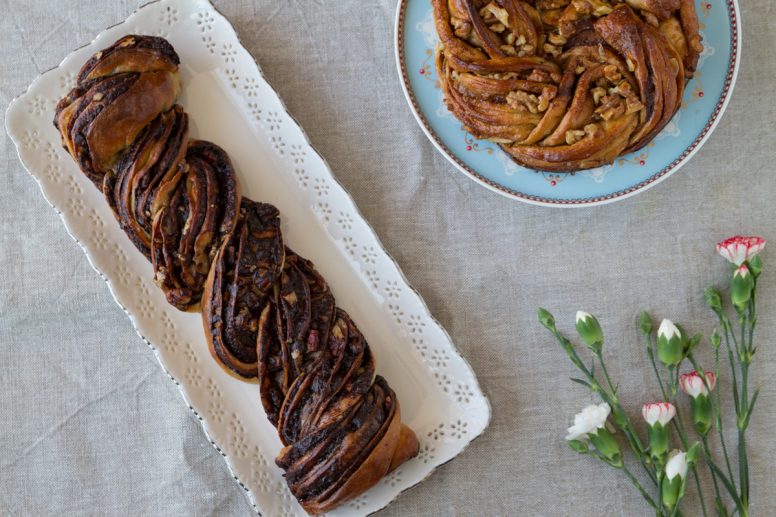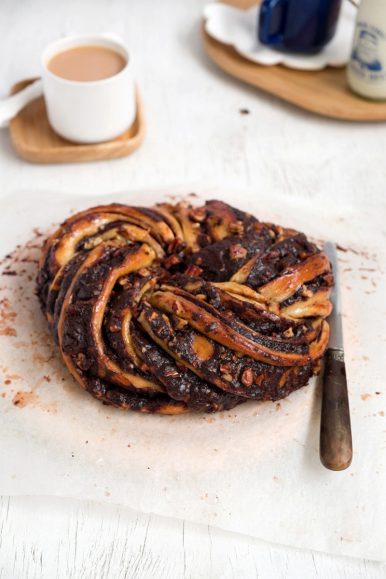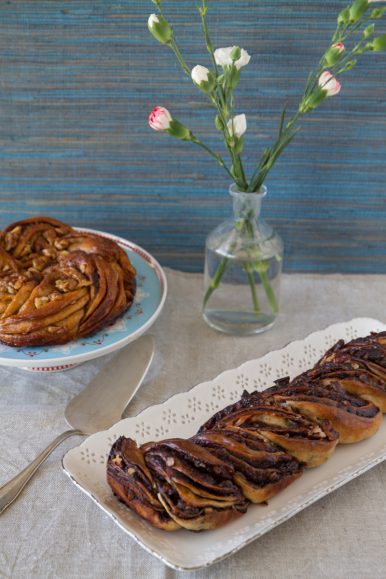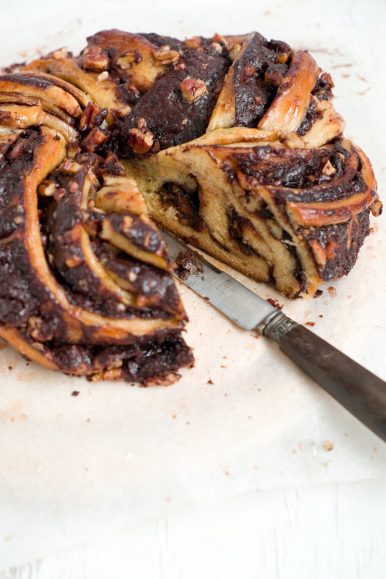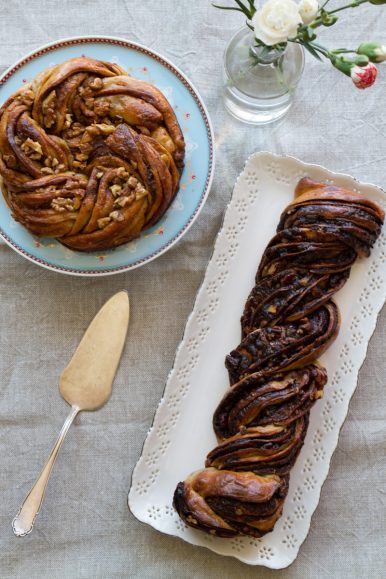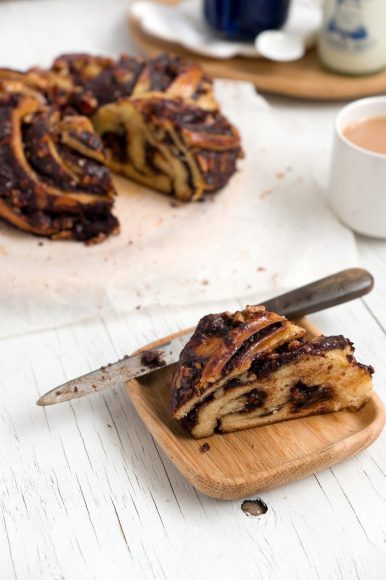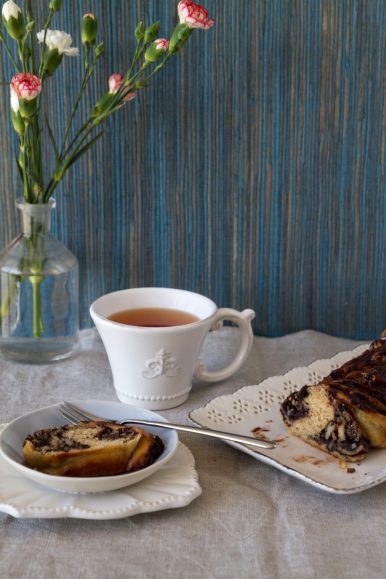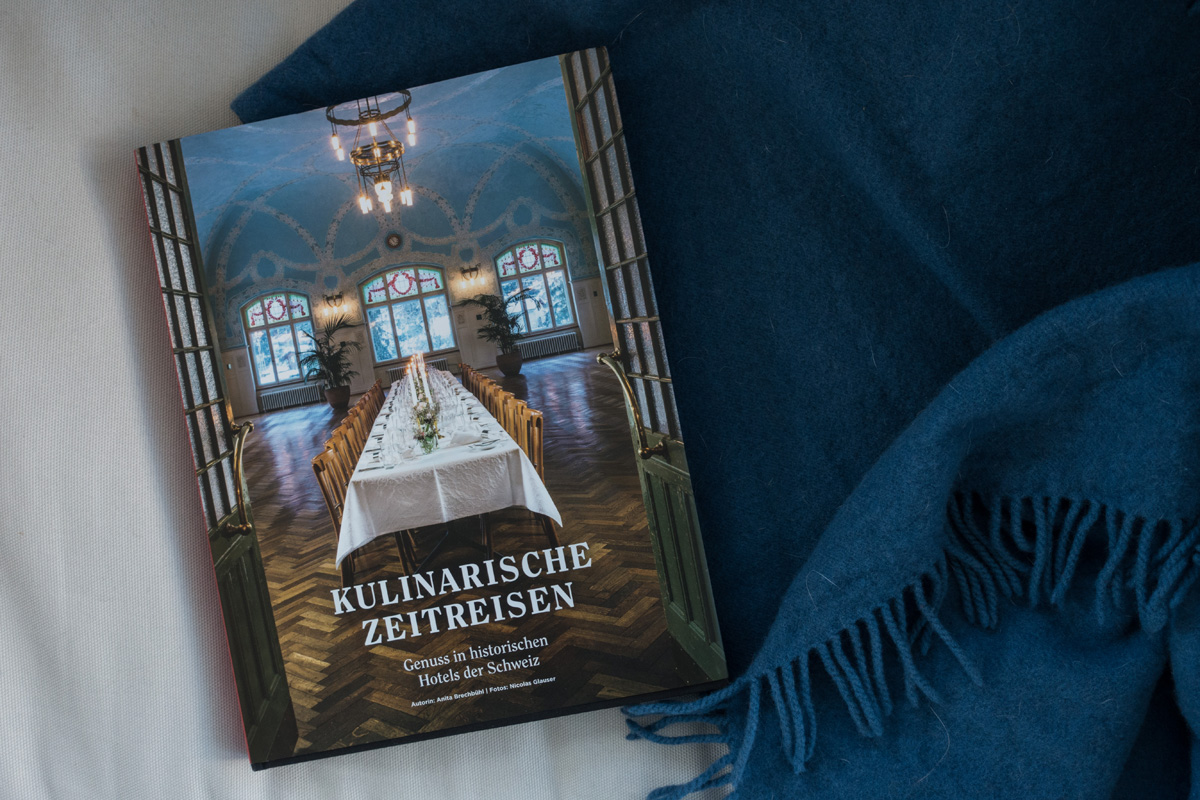The fourth Plate to Plate challenge features another Yotam Ottolenghi recipe, this time from his “Jerusalem” cookbook. When Jillian suggested a chocolate babka, I was all in. I love a good yeasted sweet bread, one of my favorites being a “nut braid”. My mother has already made this chocolate babka many times and every time tells me how delicious it is. The nice thing about the recipe is that you can play with the fillings. As the recipe makes two babkas, I made one with chocolate and one with walnuts, using Ottolenghi’s suggestions in the recipe.
Jillian’s photos are on the left.
I used a mixture of spelt and wheat flours which resulted in a stiffer dough to work with. The chocolate mixture “glued” the strips together so twisting the babka wasn’t a problem at all. The walnut babka with cinnamon and butter was more of a problem as there wasn’t anything sticky to keep the dough together. So I worked very carefully and pushed any walnuts and cinnamon sugar back into the dough after rolling it up and putting it in a round baking pan. I put the four ends that were cut off before the twisting began into a little ramekin so none of the goodness was wasted. I didn’t use all the sugar syrup as at some point the cakes wouldn’t soak up any more. But they cakes were plenty moist and sweet eventhough I didn’t use all the syrup.
Although the dough takes a while to prepare (overnight), this recipe is a keeper. Not only is it delicious, and pretty to look at, it’s also relatively easy to make. I’m not sure which version I liked better, they were both so good. I think I may have to make the babkas sometime soon so I can taste-test them again!
Read Jillian’s post on her blog!
Chocolate Babka (Jerusalem, Ottolenghi & Tamimi)
Makes 2 loaves.
For the dough
- 530 g all-purpose flour, plus extra for dusting
- 100 g superfine sugar
- 2 tsp fast-rising active dry yeast
- 3 extra-large free-range eggs
- 120 ml water
- rounded 1/4 tsp salt
- 150 g unsalted butter, at room temperature, cut into 2cm cubes
- sunflower oil, for greasing
For the chocolate filling
- 50 g powdered sugar
- 30 g best-quality cocoa powder
- 130 g good-quality dark chocolate, melted
- 120 g unsalted butter, melted
- 00 g pecans, coarsely chopped
- 2 Tbs superfine sugar
For the sugar syrup (enough for both cakes)
- 160 ml water
- 260 g sugar
For the dough, place the flour, sugar, and yeast in a stand mixer fitted with the dough hook and mix on low speed for 1 minute. Add the eggs and water and mix on low speed for a few seconds, then increase the speed to medium and mix for 3 minutes, until the dough comes together. Add the salt and then start adding the butter, a few cubes at a time, mixing until it is incorporated into the dough. Continue mixing for about 10 minutes on medium speed, until the dough is completely smooth, elastic, and shiny.
Place the dough in a large bowl brushed with sunflower oil, cover with plastic wrap, and leave in the fridge for at least half a day, preferably overnight.
Grease two 1kg loaf pans (23 x 10 cm, or round) with some sunflower oil and line the bottom of each pan with a piece of waxed paper. Divide the dough in half and keep one-half covered in the fridge.
Make the filling by mixing together the confectioners’ sugar, cocoa powder, chocolate, and butter. You will get a spreadable paste. Roll out the dough on a lightly floured surface into a rectangle measuring 15 by 11 inches (38 by 28 cm). Trim the sides to make them even, then position the dough so that a long side is closest to you. Use an offset spatula to spread half the chocolate mixture over the rectangle, leaving a 3⁄4-inch / 2cm border all around. Sprinkle half the pecans on top of the chocolate, then sprinkle over half the superfine sugar.
Brush a little bit of water along the long end. Use both hands to roll up the rectangle like a jelly roll, starting from the long side that is opposite the side with the water and ending at the other long end. Press to seal the dampened end onto the roll and then use both hands to even out the roll into a perfect thick cigar. Rest the cigar on its seam.
Trim about 2 cm off both ends of the roll with a sharp knife. Now use the knife to gently cut the roll into half lengthwise, starting at the top and finishing at the seam. You are essentially dividing the log into two long even halves, with the layers of dough and filling visible along the length of both halves. With the cut sides facing up, gently press together one end of each half, and then lift the right half over the left half. Repeat this process, but this time lift the left half over the right, to create a simple, two-pronged plait. Gently squeeze together the other ends so that you are left with the two halves, intertwined, showing the filling on top. Carefully lift the cake into a loaf pan. Cover the pan with a wet tea towel and leave to rise in a warm place for 1 to 11⁄2 hours. The cake will rise by 10 to 20 percent. Repeat the whole process to make the second cake.
Preheat the oven to 190°C. Remove the tea towels, place the cakes on the middle rack of the oven, and bake for about 30 minutes, until a skewer inserted in the center comes out clean.
While the cakes are in the oven, make the syrup. Combine the water and sugar in a saucepan, place over medium heat, and bring to a boil. As soon as the sugar dissolves, remove from the heat and leave to cool down. As soon as the cakes come out of the oven, brush all of the syrup over them. Leave the cakes until they are just warm, then remove them from the pans and let cool completely before serving.

